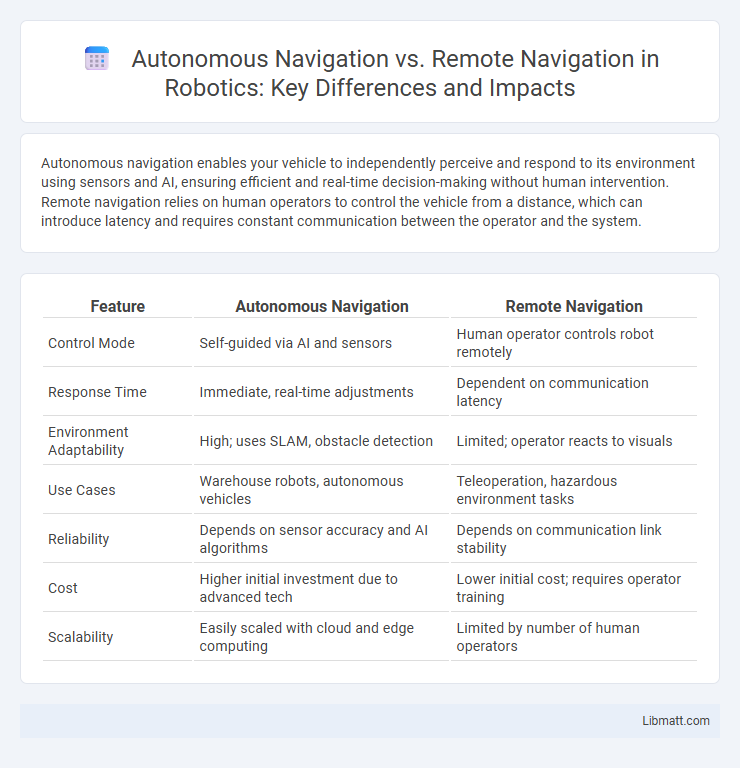Autonomous navigation enables your vehicle to independently perceive and respond to its environment using sensors and AI, ensuring efficient and real-time decision-making without human intervention. Remote navigation relies on human operators to control the vehicle from a distance, which can introduce latency and requires constant communication between the operator and the system.
Table of Comparison
| Feature | Autonomous Navigation | Remote Navigation |
|---|---|---|
| Control Mode | Self-guided via AI and sensors | Human operator controls robot remotely |
| Response Time | Immediate, real-time adjustments | Dependent on communication latency |
| Environment Adaptability | High; uses SLAM, obstacle detection | Limited; operator reacts to visuals |
| Use Cases | Warehouse robots, autonomous vehicles | Teleoperation, hazardous environment tasks |
| Reliability | Depends on sensor accuracy and AI algorithms | Depends on communication link stability |
| Cost | Higher initial investment due to advanced tech | Lower initial cost; requires operator training |
| Scalability | Easily scaled with cloud and edge computing | Limited by number of human operators |
Introduction to Navigation Technologies
Autonomous navigation leverages advanced sensors, artificial intelligence, and machine learning algorithms to enable vehicles or robots to independently interpret their environment and make real-time decisions. Remote navigation relies on human operators controlling the vehicle or device from a distance using communication systems, often requiring constant input and monitoring. Both technologies are critical in robotics, drones, and autonomous vehicles, with autonomous systems prioritizing real-time autonomy and remote systems depending on human judgment for navigation tasks.
Defining Autonomous Navigation
Autonomous navigation refers to the capability of a vehicle or robot to self-direct its movements using sensors, algorithms, and artificial intelligence without human intervention. It relies on real-time data processing to map environments, avoid obstacles, and make decisions independently. Your system's efficiency improves by integrating autonomous navigation for seamless, adaptive operation in dynamic settings.
Understanding Remote Navigation
Remote navigation involves controlling a vehicle or drone from a distance using real-time data and communication links, relying heavily on human input for decision-making. It requires robust connectivity and precise control interfaces to ensure safety and accuracy during operation in complex or unpredictable environments. This method contrasts with autonomous navigation, which uses onboard sensors and algorithms to independently interpret surroundings and execute maneuvers without continuous human intervention.
Key Differences between Autonomous and Remote Navigation
Autonomous navigation relies on advanced sensors, AI algorithms, and real-time data processing to enable vehicles or drones to make independent decisions without human intervention. Remote navigation depends on a human operator who controls the vehicle or drone via communication links, requiring constant input and oversight. Understanding these key differences helps you choose the appropriate system based on factors like reliability, response time, and operational complexity.
Technology and Components Involved
Autonomous navigation relies on advanced sensors like LiDAR, GPS, and computer vision systems integrated with AI algorithms to process real-time data and make independent decisions. Remote navigation depends on communication technologies such as radio frequencies, cameras, and control consoles, allowing a human operator to guide the vehicle from a distance. Your choice between these systems impacts the complexity of onboard components and the level of human intervention required.
Advantages of Autonomous Navigation
Autonomous navigation offers enhanced efficiency by enabling real-time decision-making without human intervention, reducing latency and error rates. It improves safety through advanced sensor integration and machine learning algorithms that detect and respond to dynamic environments more precisely than remote navigation. The scalability of autonomous systems allows for continuous operation in complex or hazardous areas where human-controlled navigation might be limited or risky.
Benefits and Challenges of Remote Navigation
Remote navigation offers enhanced operational control and safety by allowing human operators to manage vehicles from a distance, reducing risks in hazardous environments. Challenges include latency issues, limited real-time responsiveness, and dependence on stable communication networks, which can impact decision-making and maneuver precision. Your ability to maintain seamless connectivity is crucial for optimizing the effectiveness of remote navigation systems.
Real-world Applications and Use Cases
Autonomous navigation enables self-driving cars, agricultural robots, and drones to operate independently in complex environments, optimizing efficiency and safety through AI-driven decision-making. Remote navigation is critical in hazardous or inaccessible areas such as underwater exploration, space missions, and disaster response, allowing human operators to control vehicles with precision and real-time feedback. Both technologies are transforming industries by enhancing operational capabilities in contexts where direct human presence is limited or risky.
Safety, Reliability, and Human Oversight
Autonomous navigation systems leverage advanced sensors and AI algorithms to enhance safety by reducing human error and providing real-time obstacle detection, while remote navigation relies heavily on continuous human oversight for decision-making and response accuracy. Reliability in autonomous navigation depends on robust machine learning models and fail-safe mechanisms, whereas remote navigation's reliability is contingent on stable communication networks and operator alertness. Your choice between the two should consider the critical balance of safety, system reliability, and the level of human control preferred in operational environments.
Future Trends and Innovations in Navigation Systems
Future trends in navigation systems emphasize the integration of artificial intelligence and machine learning to enhance autonomous navigation's decision-making accuracy and real-time adaptability. Innovations include the deployment of advanced sensor fusion techniques combining LiDAR, RADAR, and computer vision to improve obstacle detection and route optimization without human intervention. Remote navigation advancements focus on ultra-low latency communication networks, such as 5G and beyond, enabling precise, real-time control of vehicles and drones in complex environments.
Autonomous Navigation vs Remote Navigation Infographic

 libmatt.com
libmatt.com